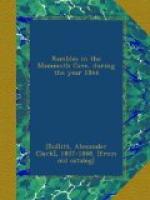Near the end of this branch, (the lower branch) there is a crevice in the ceiling over the last spring, through which the sound of water may be heard falling in a cave or open space above.
Highly gratified with what we had now seen in the Gothic Avenue, we concluded to pursue it no further, but to retrace our steps to the Main Cave, regretting however, that we had not visited the Salts Cave, (a branch of the Gothic Avenue,) on being told, when too late, that it would have amply compensated us for our trouble, being rich in fine specimens of Epsom or Glauber salts.
CHAPTER IV.
The Ball-Room—Willie’s Spring—Wandering Willie—Ox-Stalls—Giant’s Coffin—Acute-Angle or Great Bend—Range of Cabins—Curative Properties of the Cave Air long known.
We are now again in the Main Cave or Grand Gallery, which continues to increase in interest as we advance, eliciting from our party frequent and loud exclamations of admiration and wonder. Not many steps from the stairs leading down from the Gothic Avenue into the Main Cave, is the Ball-Room, so called from its singular adaptedness to such a purpose; for there is an orchestra, fifteen or eighteen feet high, large enough to accommodate a hundred or more musicians, with a gallery extending back to the level of the high embankment near the Gothic Avenue; besides which, the avenue here is lofty, wide, straight and perfectly level for several hundred feet. At the trifling expense of a plank floor, seats and lamps, a ball-room might be had, if not more splendid, at all events more grand and magnificent than any other on earth. The effect of music here would be truly inspiring; but the awful solemnity of the place may, in the opinion of many, prevent its being used as a temple of Terpsichore. Extremes, we are told, often meet. The same objection has been urged against the Cave’s being used for religious services. “No clergyman,” remarked a distinguished divine, “be he ever so eloquent could concentrate the attention of his congregation in such a place. The God of nature speaks too loud here for man to be heard.”
Leaving these points to be settled as they may, we will proceed onwards; the road now is broad and fine, and in many places dusty. Next in order is Willie’s Spring, a beautifully fluted niche in the left hand wall, caused by the continual attrition of water trickling down into a basin below. This spring derives its name from that of a young gentleman, the son of a highly respectable clergyman of Cincinnati, who, in the spirit of romance, assumed the name of Wandering Willie, and taking with him his violin, marched on foot to the Cave. Wishing no better place in which to pass the night, he selected this spot, requesting the guide to call for him in the morning. This he did and found him fast asleep upon his bed of earth, with his violin beside him—ever since it has been called Willie’s Spring. Just beyond




